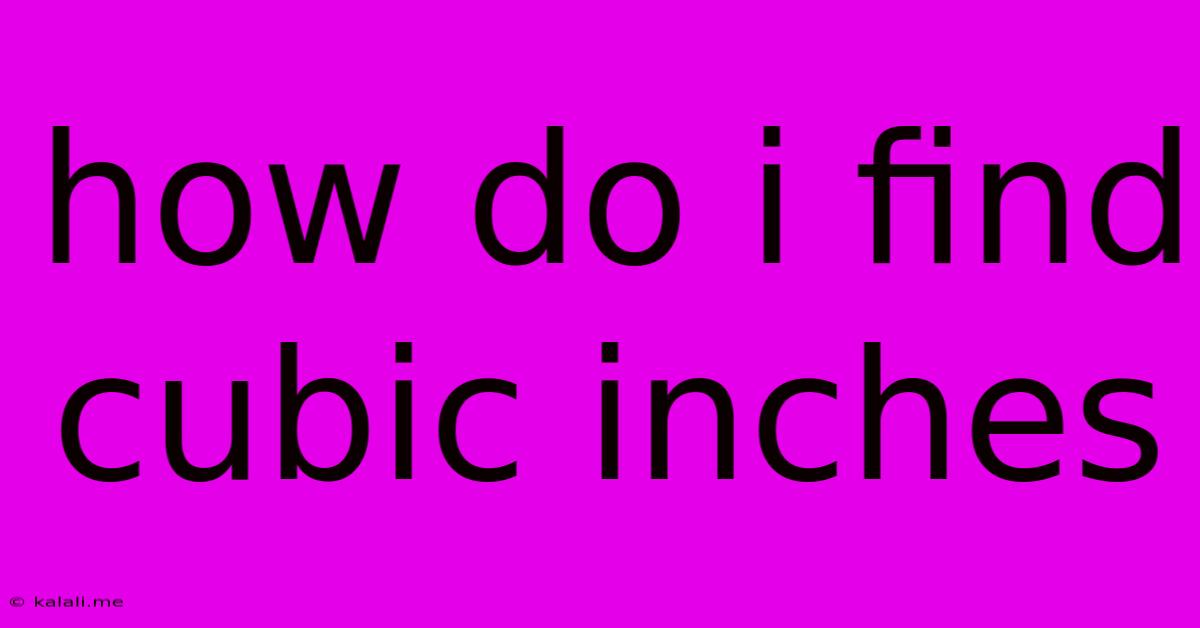How Do I Find Cubic Inches
Kalali
Jun 07, 2025 · 3 min read

Table of Contents
How to Find Cubic Inches: A Comprehensive Guide
Finding cubic inches is a fundamental calculation used in various fields, from engineering and manufacturing to shipping and even cooking. Understanding how to calculate cubic inches, often represented as cu in or in³, is crucial for determining volume and capacity. This guide will walk you through different methods and scenarios, helping you master this essential measurement.
What are Cubic Inches?
Cubic inches represent the volume of a three-dimensional space, measured in inches. Imagine a cube with sides measuring one inch each; its volume is one cubic inch. This concept extends to any shape, calculating the total space enclosed within its three-dimensional boundaries. Knowing how to find cubic inches is key for tasks like determining the packaging size needed for an item, calculating the capacity of a container, or even understanding engine displacement.
Methods for Calculating Cubic Inches
The approach to finding cubic inches depends largely on the shape of the object. Here are the most common methods:
Calculating Cubic Inches for Regular Shapes
For simple shapes like cubes and rectangular prisms (boxes), the calculation is straightforward:
1. Cubes:
- Formula: Side * Side * Side (or Side³)
- Example: A cube with sides measuring 5 inches each has a volume of 5 * 5 * 5 = 125 cubic inches.
2. Rectangular Prisms:
- Formula: Length * Width * Height
- Example: A rectangular box with a length of 10 inches, a width of 4 inches, and a height of 6 inches has a volume of 10 * 4 * 6 = 240 cubic inches.
Calculating Cubic Inches for Irregular Shapes
Finding the cubic inches of irregularly shaped objects requires more advanced techniques:
1. Water Displacement Method:
This is a practical method for irregular objects that can be submerged in water.
- Fill a container with a known volume of water.
- Submerge the object completely.
- Measure the change in water level. The volume of the displaced water equals the object's volume in cubic inches. Remember to convert the water level measurements from whatever unit is used (e.g., centimeters) into inches.
2. Using a 3D Scanner:
Modern 3D scanners can precisely measure the dimensions of complex shapes. The software associated with these scanners will typically calculate the volume directly in cubic inches. This is a high-precision method but requires specialized equipment.
3. Approximation through Geometric Decomposition:
For somewhat irregular objects, you can approximate their volume by breaking them down into simpler geometric shapes (cubes, cylinders, etc.). Calculate the volume of each simpler shape and add them together for an estimate of the total cubic inches. This method's accuracy depends on how well the simpler shapes approximate the original object.
Practical Applications of Cubic Inch Calculations
Understanding cubic inches has numerous real-world applications:
- Shipping and Packaging: Determining the appropriate box size for shipping packages.
- Engineering and Manufacturing: Calculating the volume of components and materials.
- Construction: Estimating the amount of concrete, sand, or other materials needed for a project.
- Automotive: Measuring engine displacement.
- Cooking: Measuring ingredients accurately in recipes.
Mastering Cubic Inch Calculations
Learning how to find cubic inches is a valuable skill with applications across many fields. By understanding the basic formulas and employing appropriate methods for various shapes, you can accurately calculate volume and make informed decisions in a variety of situations. Remember to always use consistent units (inches) throughout your calculations to avoid errors. Whether you're dealing with simple boxes or complex shapes, mastering this calculation provides a solid foundation for problem-solving in many contexts.
Latest Posts
Latest Posts
-
How To Remove Drill Bit Dewalt
Jun 08, 2025
-
How To Clear Cookies On Twitter
Jun 08, 2025
-
Cardholder Name American Express Gift Card
Jun 08, 2025
-
Can I Take Glass On A Plane
Jun 08, 2025
-
Cups In Box Of Powdered Sugar
Jun 08, 2025
Related Post
Thank you for visiting our website which covers about How Do I Find Cubic Inches . We hope the information provided has been useful to you. Feel free to contact us if you have any questions or need further assistance. See you next time and don't miss to bookmark.